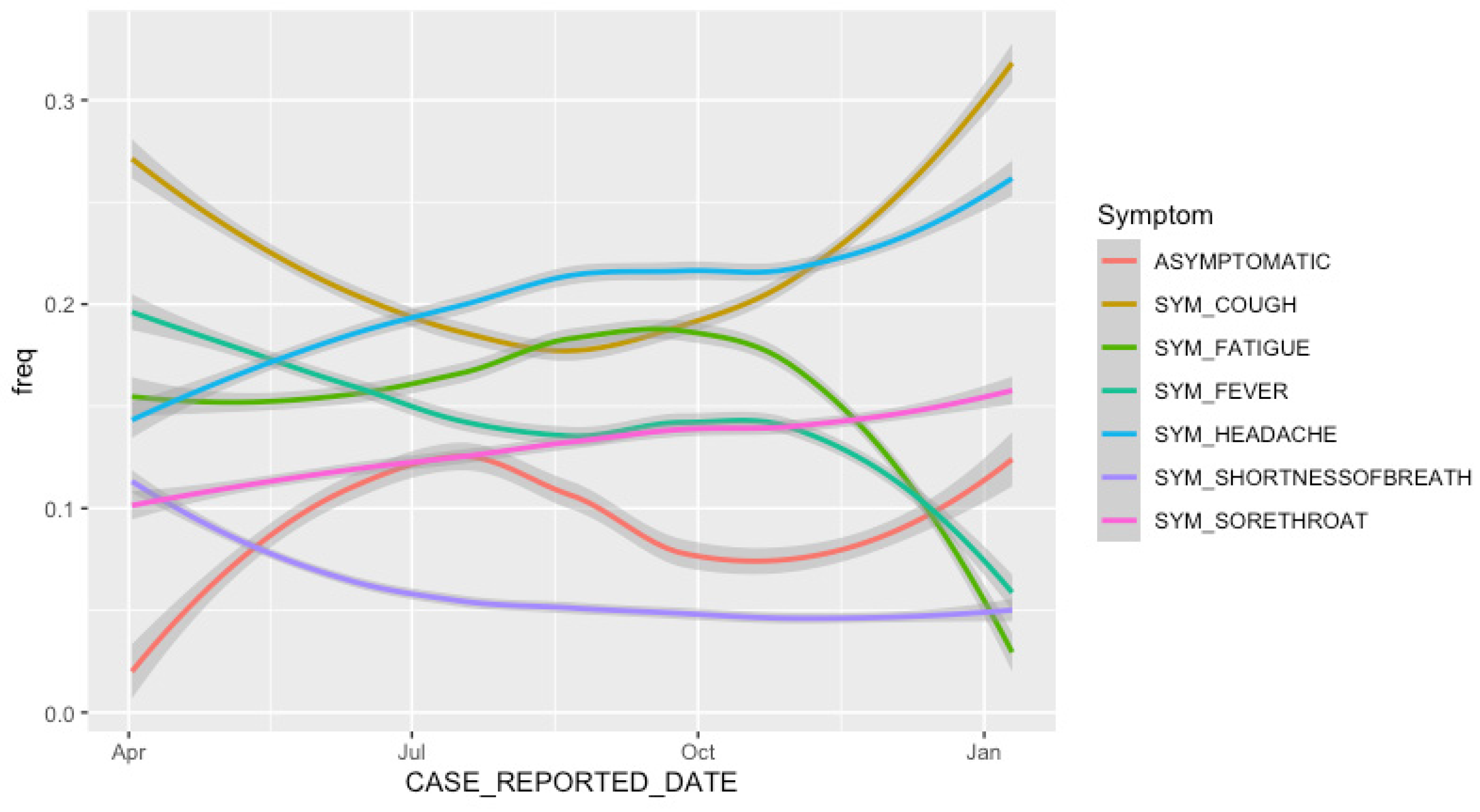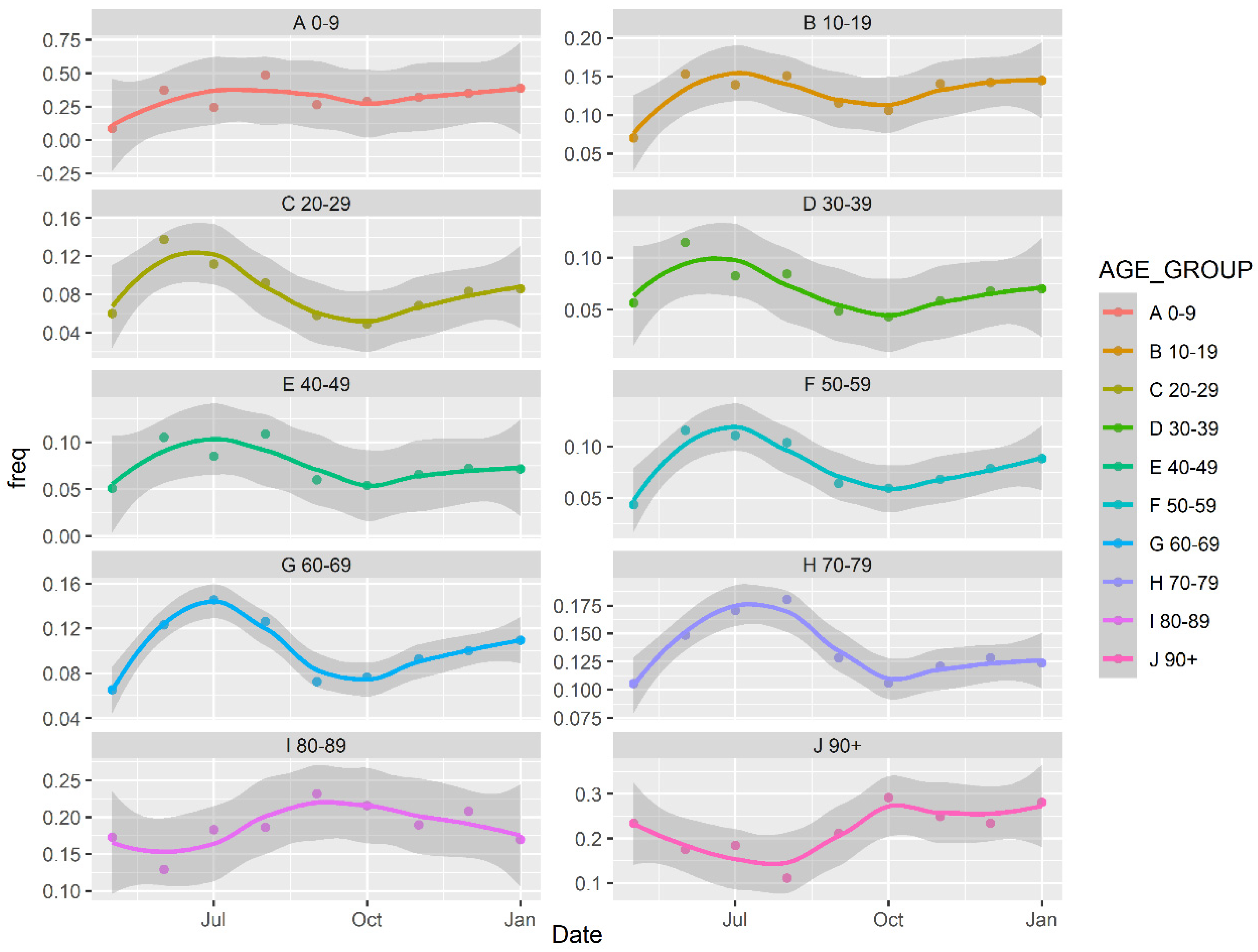Asymptomatic Cases, the Hidden Challenge in Predicting COVID-19 Caseload Increases
Abstract
1. Introduction
2. Materials and Methods
3. Literature Review
4. Results
5. Discussion
6. Conclusions
Author Contributions
Funding
Institutional Review Board Statement
Informed Consent Statement
Data Availability Statement
Acknowledgments
Conflicts of Interest
References
- Coronavirus Resource Center. Johns Hopkins University & Medicine. Available online: https://coronavirus.jhu.edu/us-map (accessed on 16 March 2021).
- COVID-19 Dashboard by the Center of Systems Science and Engineering (CSSE) at JHU. Johns Hopkins University & Medicine. Available online: https://coronavirus.jhu.edu/map.html (accessed on 11 March 2021).
- Subramanian, R.; He, Q.; Pascual, M. Quantifying asymptomatic infection and transmission of COVID-19 in New York City using observed cases, serology, and testing capacity. Proc. Natl. Acad. Sci. USA 2021, 11, e2019716118. [Google Scholar] [CrossRef] [PubMed]
- Centers for Disease Control and Prevention (CDC). COVID-19 Pandemic Planning Scenarios. Available online: https://www.cdc.gov/coronavirus/2019-ncov/hcp/planning-scenarios.html (accessed on 11 March 2021).
- CDC. Interim Clinical Guidance for Management of Patients with Confirmed Coronavirus Disease (COVID-19). Available online: https://www.cdc.gov/coronavirus/2019-ncov/hcp/clinical-guidance-management-patients.html (accessed on 1 February 2021).
- Oran, D.P.; Topo, E.J. Prevalence of asymptomatic SARS-CoV-2 infection: A narrative review. Ann. Intern. Med. 2020, 173, 362–367. [Google Scholar] [CrossRef] [PubMed]
- He, X.; Lau, E.H.Y.; Wu, P.; Deng, X.; Wang, J.; Hao, X.; Lau, Y.C.; Wong, J.Y.; Guan, Y.; Tan, X.; et al. Temporal dynamics in viral shedding and transmissibility of COVID-19. Nat. Med. 2020, 26, 672–675. [Google Scholar] [CrossRef] [PubMed]
- Ma, S.; Zhang, J.; Zeng, M.; Yun, Q.; Guo, W.; Zheng, Y.; Zhao, S.; Wang, M.H.; Yang, Z. Epidemiological Parameters of COVID-19: Case Series Study. J. Med. Internet Res. 2020, 22, e19994. [Google Scholar] [CrossRef] [PubMed]
- Zhang, W.; Cheng, W.; Luo, L.; Ma, Y.; Xu, C.; Qin, P.; Zhang, Z. Secondary Transmission of Coronavirus Disease from Presymptomatic Persons, China. Emerg. Infect. Dis. 2020, 26, 1924–1926. [Google Scholar] [CrossRef] [PubMed]
- The R Foundation. The R Project for Statistical Computing. Available online: https://www.R-project.org (accessed on 10 March 2021).
- Microsoft Excel. Available online: https://www.microsoft.com/en-us/microsoft-365/excel (accessed on 25 February 2021).
- Snider, B.; McBean, E.; Yawney, J.; Gadsden, S.A.; Patel, B. Identification of Variable Importance for Predictions of Mortality from COVID-19 Using AI Models for Ontario, Canada. Front. Public Health. (under review).
- Han, M.S.; Choi, E.H.; Chang, S.H.; Jin, B.-L.; Lee, E.J.; Kim, B.N.; Kim, M.K.; Doo, K.; Seo, J.-H.; Kim, Y.-J.; et al. Clinical Characteristics and Viral RNA Detection in Children With Coronavirus Disease 2019 in the Republic of Korea. JAMA Pediatr. 2020, 175, 73–80. [Google Scholar] [CrossRef] [PubMed]
- Li, R.; Pei, S.; Chen, B.; Song, Y.; Zhang, T.; Yang, W.; Shaman, J. Substantial undocumented infection facilitates the rapid dissemination of novel coronavirus (SARS-CoV-2). Science 2020, 368, 489–493. [Google Scholar] [CrossRef] [PubMed]
- Spencer, D. Two Seconds of Torture to Get Days of Fun. Waterloo Region Record. Available online: https://www.pressreader.com/canada/waterloo-region-record/20210312/textview (accessed on 15 March 2021).
- Public Health Ontario. COVID19—What We Know So Far about Infection in Children; Queens’s Printer for Ontario: Toronto, ON, Canada, 2020. [Google Scholar]
- Mossong, J.; Hens, N.; Jit, M.; Beutels, P.; Auranen, K.; Mikolajczyk, R.; Massari, M.; Salmaso, S.; Tomba, G.S.; Wallinga, J.; et al. Social Contacts and Mixing Patterns Relevant to the Spread of Infectious Diseases. PLoS Med. 2008, 5, 381–391. [Google Scholar] [CrossRef] [PubMed]
- Laxminarayan, R.; Wahl, B.; Dudala, S.R.; Gopal, K.; Mohan, C.; Neelima, S.; Reddy, K.S.J.; Radhakrishnan, J.; Lewnard, J.A. Epidemiology and transmission dynamics of COVID-19 in two Indian states. Science 2020, 370, 691–697. [Google Scholar] [CrossRef] [PubMed]
- Lee, M.; Son, H.; Eun, Y.; Park, K.; Heo, J. Follow-up investigation of asymptomatic COVID-19 cases at diagnosis in Busan, Korea. Epidemiol. Health 2020, 42, e2020046. [Google Scholar] [CrossRef] [PubMed]
- Pan, X.; Chen, D.; Xia, Y.; Wu, X.; Li, T.; Ou, X.; Zhou, L.; Liu, J. Asymptomatic cases in a family cluster with SARS-CoV-2 infection. Lancet Infect. Dis. 2020, 20, 410–411. [Google Scholar] [CrossRef]
- Zhang, Y.; Su, X.; Chen, W.; Fei, C.N.; Guo, L.R.; Wu, X.L.; Zhou, N.; Guo, Y.T.; Dong, X.C.; Zhao, Y.; et al. Epidemiological investigation on a cluster epidemic of COVID-19 in a collective workplace in Tianjin. Zhonghua Liu Xing Bing Xue Za Zhi 2020, 41, 649–653. [Google Scholar]
- Yang, Z.-D.; Zhou, G.-J.; Jin, R.-M.; Liu, Z.-S.; Dong, Z.-Q.; Xie, X.; Song, G.-W. Clinical and transmission dynamics characteristics of 406 children with coronavirus disease 2019 in China: A review. J. Infect. 2020, 81, e11–e15. [Google Scholar]
- A Confidence Interval for a Population Proportion. BCcampus. Available online: https://opentextbc.ca/introbusinessstatopenstax/chapter/a-confidence-interval-for-a-population-proportion/ (accessed on 31 March 2021).
- Cleveland, W.S.; Grosse, E.; Shyu, W.M. Chapter 8: Local Regression Models. In Statistical Models in S, 1st ed.; Chambers, J.M., Hastie, T.J., Eds.; Taylor and Francis Group: Boca Raton, FL, USA, 1992. [Google Scholar]
- Public Health Ontario. Ontario COVID-19 Data Tool. Available online: https://www.publichealthontario.ca/en/data-and-analysis/infectious-disease/covid-19-data-surveillance/covid-19-data-tool?tab=labTests (accessed on 1 April 2021).
- Johns Hopkins. COVID-19 Testing: Understanding the “Percent Positive”. Available online: https://www.jhsph.edu/covid-19/articles/covid-19-testing-understanding-the-percent-positive.html (accessed on 2 April 2021).
- Champredon, D.; Moghadas, S.M. Quantifying the contribution of asymptomatic infection to the cumulative incidence. Epidemiol. Infect. 2017, 145, 1256–1258. [Google Scholar] [CrossRef] [PubMed]
- Leung, C. The younger the milder clinical course of COVID-19: Even in newborns? Pediatr. Allergy Immunol. 2020, 32, 358–362. [Google Scholar] [CrossRef] [PubMed]
- Ogilvie, M. Greater Toronto Hospitals Warn Parents: Mild Symptoms Mean a Strong Likelihood of COVID. Toronto Star. Available online: https://www.thestar.com/news/gta/2021/02/20/greater-toronto-hospitals-warn-parents-mild-symptoms-mean-a-strong-likelihood-of-covid.html (accessed on 20 February 2021).
- Du, W.; Yu, J.; Wang, H.; Zhang, X.; Zhang, S.; Li, Q.; Zhang, Z. Clinical characteristics of COVID-19 in children compared with adults in Shandong Province, China. Infection 2020, 23, 445–452. [Google Scholar] [CrossRef] [PubMed]
- Yang, P.; Liu, P.; Li, D.; Zhao, D. Corona Virus Disease 2019, a growing threat to children? J. Infect. 2020, 80, 671–693. [Google Scholar] [CrossRef] [PubMed]
- Oran, D.P.; Topol, E.J. The Proportion of SARS-CoV-2 Infections That Are Asymptomatic. A Systemic Review. Ann. Intern. Med. 2021. [Google Scholar] [CrossRef] [PubMed]
- Taylor, B. ‘Pandemic within a Pandemic’: Expert Sounds the Alarm over Variants in Ontario. CTV News. Available online: https://www.ctvnews.ca/health/coronavirus/pandemic-within-a-pandemic-expert-sounds-the-alarm-over-variants-in-ontario-1.5343307 (accessed on 11 March 2021).


| % of Total Cases | Total | ||||
|---|---|---|---|---|---|
| Age Group | 0 Symptoms | 1 Symptom | 2 Symptoms | ≥3 Symptoms | Number of Cases with Known Symptoms |
| 0–9 | 35.0 ± 2.7 | 31.4 ± 2.6 | 22.3 ± 2.3 | 11.3 ± 1.8 | 1216 |
| 10–19 | 11.4 ± 0.9 | 28.0 ± 1.2 | 29.5 ± 1.2 | 31.1 ±1.2 | 5276 |
| 20–29 | 6.6 ± 0.4 | 22.4 ± 0.7 | 27.9 ± 0.8 | 43.0 ± 0.9 | 12,458 |
| 30–39 | 6.8 ± 0.5 | 21.3 ± 0.9 | 27.3 ± 0.9 | 44.6 ± 1.1 | 8562 |
| 40–49 | 7.6 ± 0.6 | 21.8 ± 0.9 | 27.2 ± 1.0 | 43.5 ± 1.1 | 7341 |
| 50–59 | 7.8 ± 0.6 | 20.8 ± 1.0 | 27.7 ± 1.1 | 43.7 ± 1.2 | 6829 |
| 60–69 | 8.8 ± 0.9 | 21.6 ± 1.3 | 27.8 ± 1.4 | 41.8 ± 1.6 | 3818 |
| 70–79 | 15.2 ± 1.8 | 24.2 ± 2.2 | 24.9 ± 2.2 | 35.6 ± 2.4 | 1522 |
| 80–89 | 31.2 ± 3.1 | 20.1 ± 2.7 | 25.8 ± 2.9 | 22.9 ± 2.8 | 877 |
| ≥90 | 42.2 ± 4.7 | 18.9 ± 3.7 | 24.0 ± 4.0 | 14.9 ± 3.4 | 429 |
| Rank | Symptom | Number of Cases | % |
|---|---|---|---|
| 1 | Cough | 56785 | 25.9 ± 0.4 |
| 2 | Headache | 50132 | 15.8 ± 0.3 |
| 3 | Fatigue | 34643 | 15.1 ± 0.4 |
| 4 | Fever | 33155 | 22.9 ± 0.5 |
| 5 | Sore throat | 32127 | 6.4 ± 0.3 |
| 6 | Shortness of breath | 14049 | 14.7 ± 0.6 |
Publisher’s Note: MDPI stays neutral with regard to jurisdictional claims in published maps and institutional affiliations. |
© 2021 by the authors. Licensee MDPI, Basel, Switzerland. This article is an open access article distributed under the terms and conditions of the Creative Commons Attribution (CC BY) license (https://creativecommons.org/licenses/by/4.0/).
Share and Cite
Snider, B.; Patel, B.; McBean, E. Asymptomatic Cases, the Hidden Challenge in Predicting COVID-19 Caseload Increases. Infect. Dis. Rep. 2021, 13, 340-347. https://doi.org/10.3390/idr13020033
Snider B, Patel B, McBean E. Asymptomatic Cases, the Hidden Challenge in Predicting COVID-19 Caseload Increases. Infectious Disease Reports. 2021; 13(2):340-347. https://doi.org/10.3390/idr13020033
Chicago/Turabian StyleSnider, Brett, Bhumi Patel, and Edward McBean. 2021. "Asymptomatic Cases, the Hidden Challenge in Predicting COVID-19 Caseload Increases" Infectious Disease Reports 13, no. 2: 340-347. https://doi.org/10.3390/idr13020033
APA StyleSnider, B., Patel, B., & McBean, E. (2021). Asymptomatic Cases, the Hidden Challenge in Predicting COVID-19 Caseload Increases. Infectious Disease Reports, 13(2), 340-347. https://doi.org/10.3390/idr13020033






